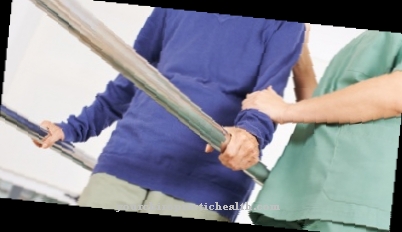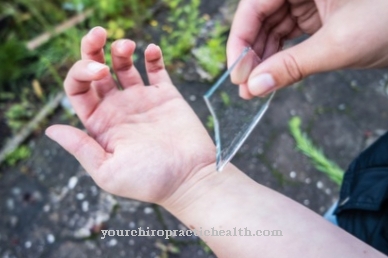Most of the time after an accident or a similarly heavy burden on the body and mind, this can occur suddenly Circulatory shock develop. Just like an allergic shock (anaphylactic shock), circulatory shock is also a life-threatening condition.
causes

As already mentioned, a circulatory shock usually arises in connection with a traffic accident or other type of accident. The reason for this is that the brain and organs need more oxygen than the blood can carry in circulatory shock. The body tries to stimulate the cardiovascular system by increasing the production of adrenaline. In addition, almost all of the blood vessels in the organs are contracted.
If the circulatory shock lasts longer, the blood becomes acidic, thickens, forms plugs and can hardly give off any carbon dioxide. This then leads to the elimination of individual organs. As a result, the blood pressure fell sharply and the brain is no longer supplied with sufficient oxygen by the blood.
Typical accompanying symptoms of circulatory shock include a weak pulse, a pale face (pale face), cold skin, freezing, cold sweat, restlessness and a complete physical breakdown. Elderly people and people with vascular diseases as well as young women and pregnant women are particularly at risk of circulatory shocks (heat strokes) from heat waves in the summer months. Circulatory shocks can also be associated with diseases such as cholera, pulmonary embolism, etc. stand.
Diseases with this symptom
- Pulmonary embolism
- Circulatory disorders
- Ectopic pregnancy
- cholera
- Insect venom allergy
- Intestinal obstruction (ileus)
- Arterial Disease
- Hives
- Peritonitis
Complications
In the acute state of circulatory shock, the body is characterized by restlessness and rapid breathing, as well as shortness of breath, as the tissues are only insufficiently supplied with oxygen. Since this is a medical emergency, the circulatory shock should be treated as soon as possible as it can lead to dizziness and loss of consciousness. There is also a threat of failure in multiple organs. In the worst case, this can lead to death.
Damage to the kidneys is one of the first complications that manifests itself in circulatory shock, as the kidneys must be constantly supplied with blood. A lack of blood supply quickly takes on permanent damage. Affected people do not pass urine during circulatory shock.
In addition to the kidneys, the lungs can also be affected by circulatory shock and an ARDS (adult respiratory distress syndrome) develops, i.e. an acute failure of the lungs, which can result in acute left heart failure. The normal soft and muscle tissue are also affected by the insufficient supply due to circulatory shock.
Due to the lack of oxygen, these tissues can die, necrosis and gangrene form, which is also characterized by shrinkage and drying of the tissue, as well as a blackish color. There is also a risk that the gangrene could become infected with putrefactive bacteria and the tissue would rot.
When should you go to the doctor?
Circulatory shock is a symptom and not an independent clinical picture, so the cause of this symptom must first be found. In general, people affected who suffer from serious circulatory problems should definitely consult a doctor. This is the only way to find the cause of this clinical picture and treat it accordingly. In most cases, insufficient fluid intake is responsible for circulatory problems.
For this reason, those affected should drink enough to avoid future symptoms at an early stage. It is not uncommon for people with infection to also suffer from considerable circulatory problems. At the same time, other complaints such as fever, vomiting, chills or long-lasting nausea often occur. If you want to avoid the symptoms just mentioned at an early stage, you should definitely consult a doctor.
A doctor can determine the cause of the permanent circulatory problems. Anyone who would also like to have serious and serious illnesses identified and treated at an early stage should not wait too long before visiting a doctor. The earlier a serious illness is detected, the better the chances of a quick and complete recovery.
Doctors & therapists in your area
Treatment & Therapy
Since circulatory shock is a life-threatening condition, it must be treated immediately by a doctor. An emergency doctor should be alerted at the slightest suspicion of circulatory shock. As soon as the doctor arrives, he will artificially ventilate the patient with oxygen. Circulatory syringes and infusions are usually just as necessary.
Blood pressure and heartbeat as well as the heart rate are constantly monitored with the help of the EKG. Most likely, further hospital treatment will be required and initiated by the emergency doctor.
In the event of circulatory shock in connection with heat stroke, the body needs immediate cooling. Wet cloths are best on the neck, forehead and legs.Antipyretic drugs are not recommended. The patient should only stay in the shade.
Outlook & forecasts
Circulatory shock is always a life-threatening condition and should therefore be treated immediately by a doctor. If the treatment is not carried out or is carried out too late, in the worst case scenario it can lead to death.
The circulatory shock has a very negative effect on the circulatory system and the function of the heart, as it is no longer supplied with enough blood. The brain also suffers from circulatory shock because it is not supplied with enough oxygen. If the treatment is not given quickly enough, permanent damage can occur, which severely impair memory and thinking.
The patient must definitely be kept warm so that the body does not cool down into a life-threatening area. The emergency doctor is then usually responsible for treatment. The affected person is given oxygen and medicines to restore blood pressure to normal.
If the circulatory shock is caused by a malfunction of the heart, the heart must be treated immediately. Without treatment, another circulatory shock can occur, which can be extremely threatening if the vessels are too dilated. In some cases, surgical treatment is also necessary to combat the causes of circulatory shock.
prevention
A circulatory shock, in the form of heat stroke, can be prevented, especially in summer, with cooling and shady areas. Wearing suitable summer clothing and a cap or hat can also protect against heat stroke. Furthermore, you shouldn't overstrain yourself physically, especially in summer.
You can do that yourself
Circulatory shock is a life-threatening condition for the body. This condition must be treated promptly by a doctor. Should a patient suffer from circulatory shock, the emergency doctor must be called immediately. Until the ambulance arrives, the patient should be given artificial respiration if breathing does not work. Mouth-to-mouth resuscitation is carried out. The person's nose must be closed so that the air cannot simply escape again. Ventilation continues until the emergency doctor arrives.
Circulatory shock can usually be prevented by a healthy lifestyle. This includes a healthy diet and sporting activities. To prevent circulatory shock, people should drink enough water on hot summer days and only stay in cool places. The head in particular should be cooled and protected from the sun with a hat. Strong physical exertion should generally be avoided in summer.
The treatment is successful in most cases if it is carried out on time. After a circulatory shock, the person concerned must first rest and relax.





.jpg)


















.jpg)



